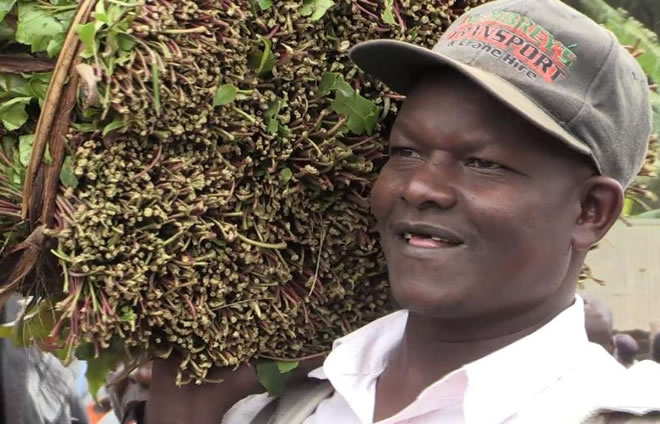Kenya, Somalia relations have been at their lowest point in years as the two countries clashed over Indian Ocean Maritime claims, Kenya’s plan to build 700km border fence and more recently Somalia miraa ban which is a two-edged sword – an epoch-making measure for Somalia but angers Kenya.
Over half a million Kenyan farmers depend on the cultivation of miraa for their livelihood. In 2016 President Uhuru Kenyata signed into a law a Bill that categorises miraa as cash crop and allocated miraa farmers Sh1 billion to deal with market shocks.
Kenya’s biggest miraa export market is Somalia. Around 20 cargo planes full of miraa/khat arrive in Somalia daily. But ironically, these planes fly back to Kenya completely empty. No wonder why the Somalia-Kenya trade deficit is so huge. The Somalia’s exported goods such as fisheries products are being shut out of the Kenyan market. In 2018, Lamu East Fishermen Association urged President Kenyata to ban fish from Somalia. As a result, in June 2019 Kenya imposed cross-border trade ban on Somali’s seafood.
Somalia miraa ban
In March 2020, Somalia banned importation of miraa from Kenya as part of measures to contain the spread of Covid-19. Coronavirus is the trigger for the latest miraa ban in Somalia but the problems of miraa run deeper than what is seen on the service. Miraa/khat is to blame for a lot of the socio-economic ills in Somalia such as family disintegration, poverty, and health problems. The consumption of miraa/khat in Somalia is more prevalent among people with a lower socio-economic status. Miraa cost on average $6 a bunch/marduuf-500g (pre-ban price). It accounts for a greater share of the consumer’s expenditure.
From the 1960s onwards the consumption of miraa in Somalia became alarmingly pervasive. According to a study done in 1983 by Abdullahi S. Elmi of Somali National University “on average 40% of adult males in Somalia regularly consumed khat. Equally the adverse health and social consequences of khat usage in Somalia became notable. Thus, In 1983 Siad Barre’s regime introduced a law banning the planting, importation and consumption of khat. According to 1987 UNODC report on khat “The programme for eradication of khat and its consumption following the prohibition law of 1983 has been successful”. The adverse effect of khat on socio-economic and health conditions of the people were improved. And more importantly the hard currency used to purchase miraa were significantly reduced. Unfortunately, the ban was eventually lifted in 1989 owing to domestic political turmoil, weakened state institutions and corruption.
In May 2016, miraa was banned in Somalia again. The former president of Somalia Hassan Sheikh Mohamud said “khat is a drug that has had adverse socio-economic consequences on the public”. However, this time the ban did not last long. The ban on miraa export from Kenya was lifted with immediate effect following a meeting between the two head of states in the 28th IGAD Summit of Heads of State held Somalia’s capital Mogadishu on 13/09/2016. Unlike the ending of miraa ban in 1989 which was a unilateral decision by the Somali government, the decision to lift the blockade of miraa imports in 2016 came after the Somali government succumbed to Kenya pressures- diverting all planes from Somalia to Wajir county airport for security checks, arbitrary arrests of Somalis in Nairobi, banking and financial sanctions on Somali business community in Kenya and some other provocative actions!
Global miraa ban
The spread of khat consumption and its negative effects has become a major concern for policy makers, academia, and civil society organisations around the world. Dr A A Gunaid, Faculty of Medicine and Health Sciences, University of Sana’a, says “Khat chewers experience euphoria followed by depression, while people who are genetically predisposed are extremely vulnerable to psychosis”. Dr Gunaid also argues that there is a correlation between khat usage and decreased economic productivity. Moreover a research article published in 2013 by Sophie Thomas of Lancaster University, UK and Tim William of University of Bristol, UK indicates “there are two main areas where khat may contribute to a shortening of life : in cases of liver failure and myocardial infarction”.
Consequently, the trade and the possession of the substance has been made illegal in many parts of the world. In January 2012 the Dutch government banned the use of miraa/khat. It has been classified under the List II (soft drugs) of the Opium Act (Opiumwet). In June 2014 UK followed suit and classified miraa/khat as a class C drug and banned all imports. Khat is also banned in majority of EU and G8 countries including USA and Canada.
What is the bigger picture?
Leaders from miraa growing regions in Kenya and anti-khat campaigners in Somalia ramp up pressure on their respective governments. Kenyan government assigns higher importance to the miraa issue than the maritime dispute between her and Somalia as miraa is both a cash crop and a top issue for voters. The miraa farmers, traders and elected leaders from Meru recently threatened that they will resort to mass protests if the miraa issue is not resolved by Kenyan government.
On the other hand, a deep anti-khat sentiment is sweeping across Somalia. Abukar Awale of Qaad-diid foundation – an ex addict, who tirelessly campaigned for the miraa ban in UK, is now leading the Somalia miraa ban campaign. Mr Awale recently urged president Farmaajo not to give in to the pressure from Uhuru to lift the miraa ban.
In 2016 ahead of lifting the miraa ban, Somalia demanded that Kenya respects the sovereignty and territorial integrity of Somalia. It was hoped but failed to materialise. On February 27, 2020, Permanent Representative of Federal Republic of Somalia to the UN, Abukar Osman, told the Security Council that “Kenya continues to be a destabilising force in Somalia, negating its engagement in AMISOM. Somalia strongly condemns such blatant violations and will take all measures to defend its sovereignty and unity, in accordance with international law. It will invoke article 35 if Kenya does not cease its actions”.
From the collapse of Somali state in 19991 up until recently, Kenya enjoyed a high degree of leverage over Somalia. But the Kenyan patron-client relationship with some of the Somali politicians and business elites is coming to an end as Somalia stands tall against Kenyan aggression. Somalia has repeatedly rejected calls to withdraw from the maritime dispute case at The Hague. Somalia has also rejected to lift the miraa ban despite the resumption of international flights on August 3, 2020 after months of Covid-19 restrictions.
To make matters worse, it is believed that Kenya armed a proxy force- Jubaland militia. Earlier this year, Turkey trained Somali special forces (Gorgor Brigade) and Jubaland militia backed by Kenya clashed at the border town of Bula Hawa. It was reported that the fighting spilled into Kenyan town of Mandera. According to BBC “The Kenyan president warned Somalia to stop provoking Kenya by violating its territorial integrity, saying the Somali army had fought on Kenyan land, creating tension and harassing residents”.
These events have serious implication for the region and beyond. There is a risk that this dangerous stalemate could truly spiral out of control. Three weeks ago the Kenyan Army invaded in Yado village near Elwak district of Gedo region in Somalia killing a civilian and abducted three others.
Key issues at stake include: the fight against terrorism, Dadaab refugee camp, the movement of people and political and economic integration of Horn of Africa. Additionally, increased enmity between the two countries could invigorate the NFD secession movement in Kenya and at the same time revive the desires of reclamation of NFD within Somalia.

Finally, it is apparent that the miraa trade in Somalia is unsustainable due to its negative impact on society. Even if the Somali government decides to lift the miraa ban, the issue of miraa in Somalia will never go away. Thus, Kenya should seek alternative markets for its miraa and stop meddling in Somalia’s domestic affairs.
Hassan Yuusuf Waal



